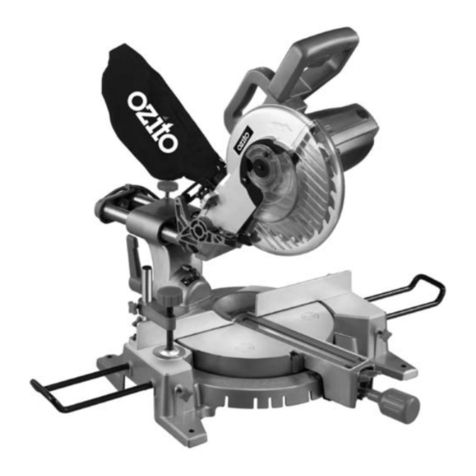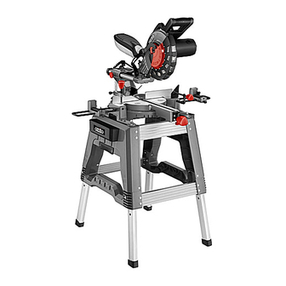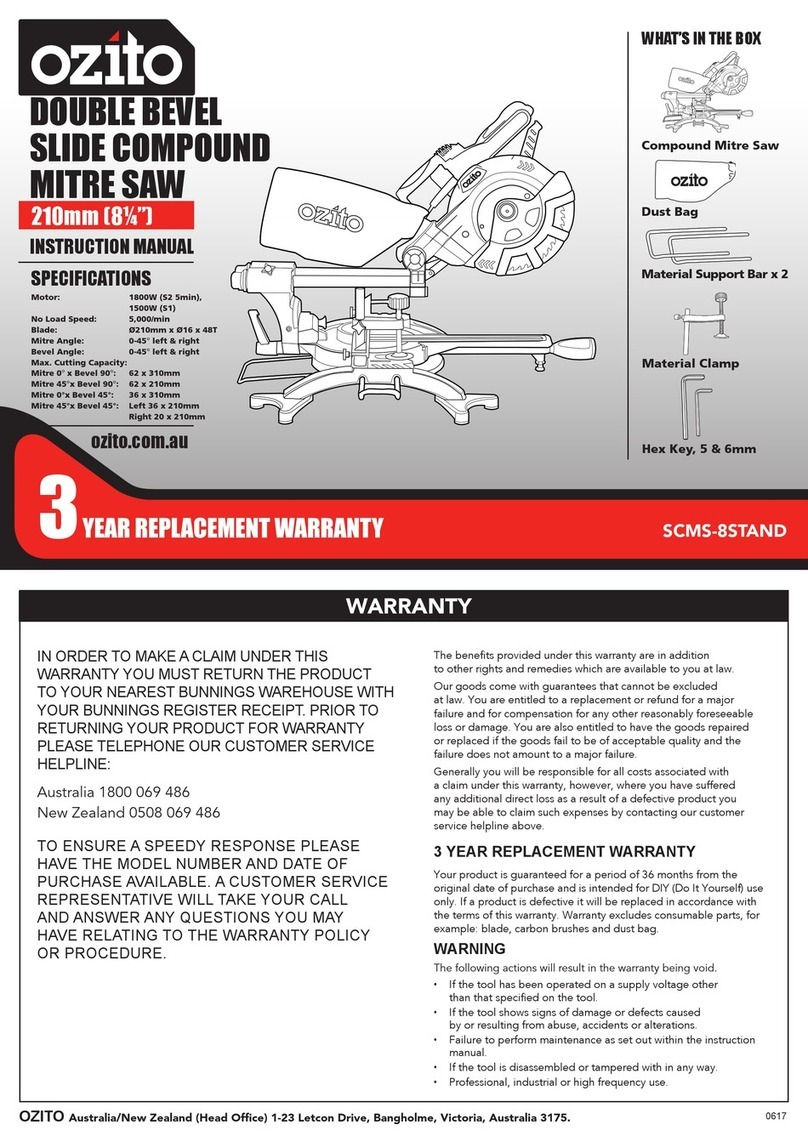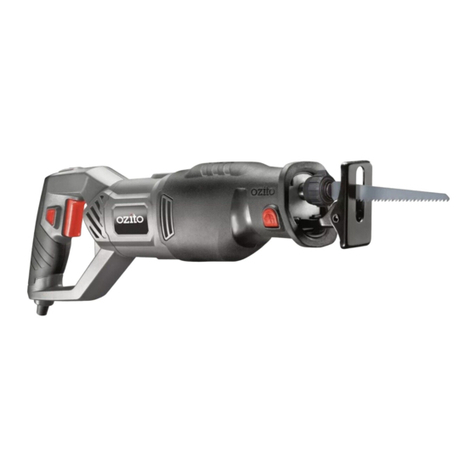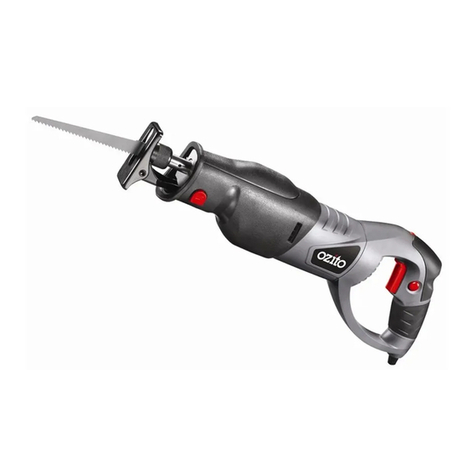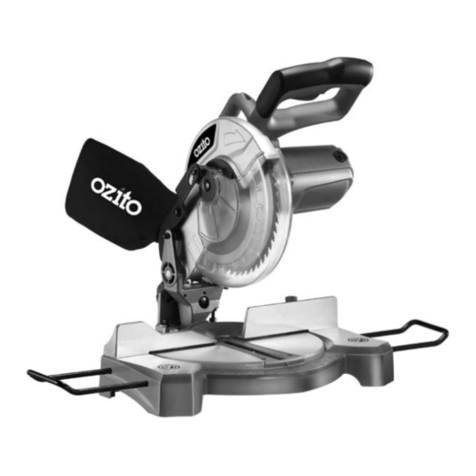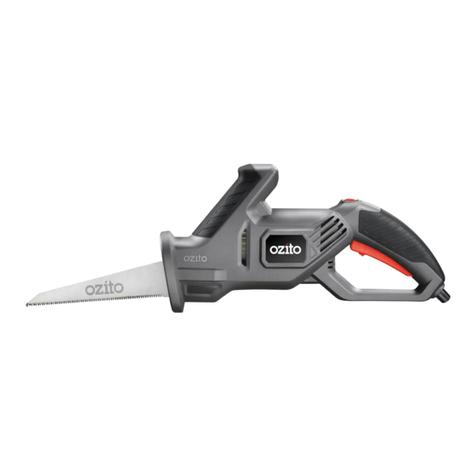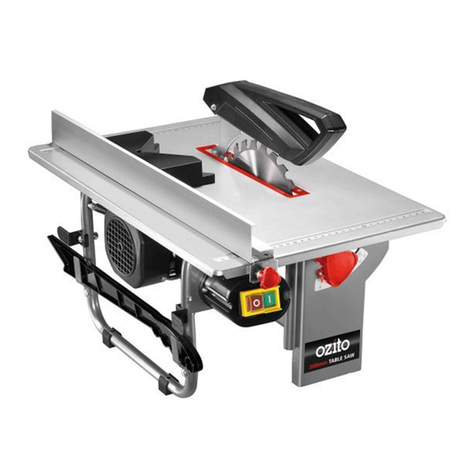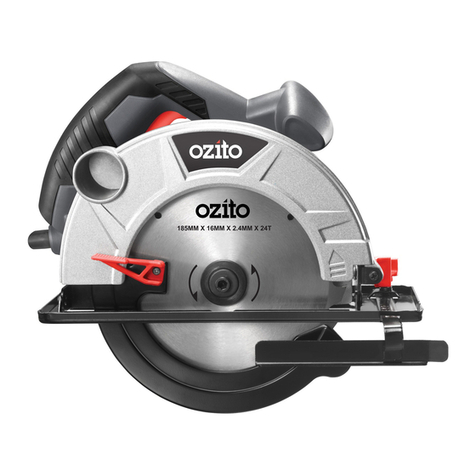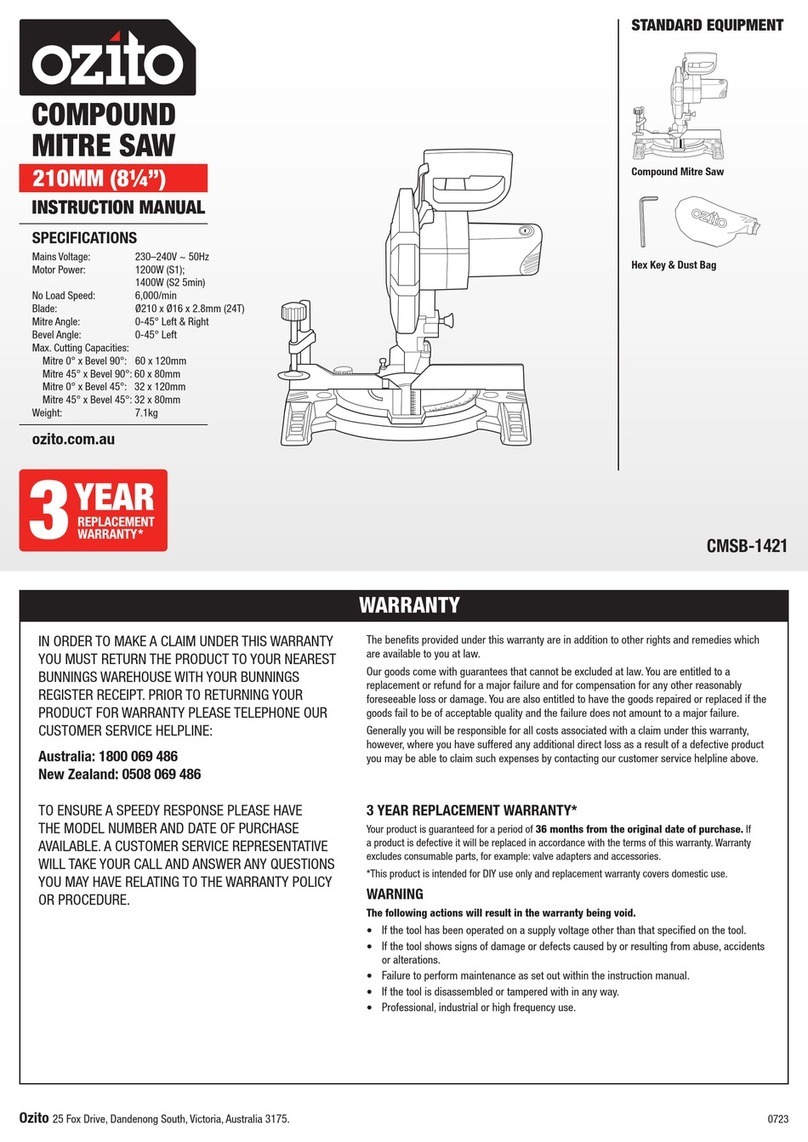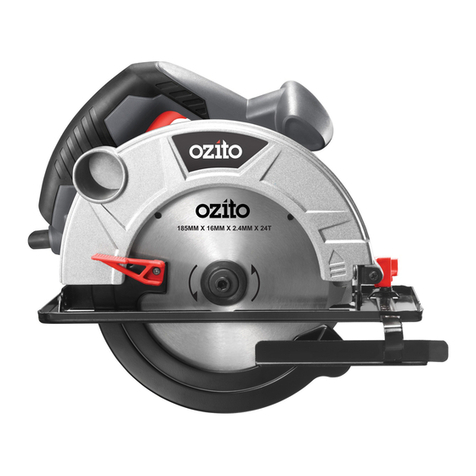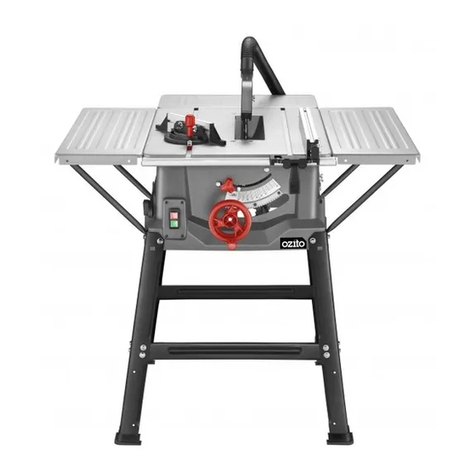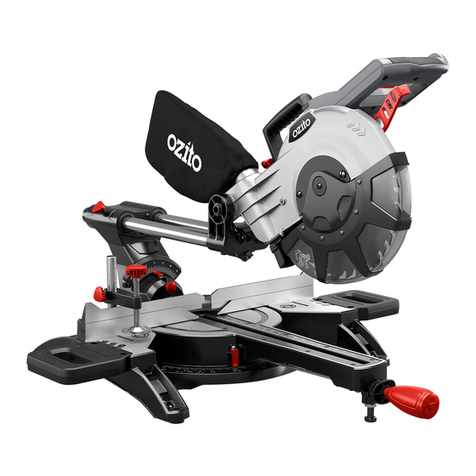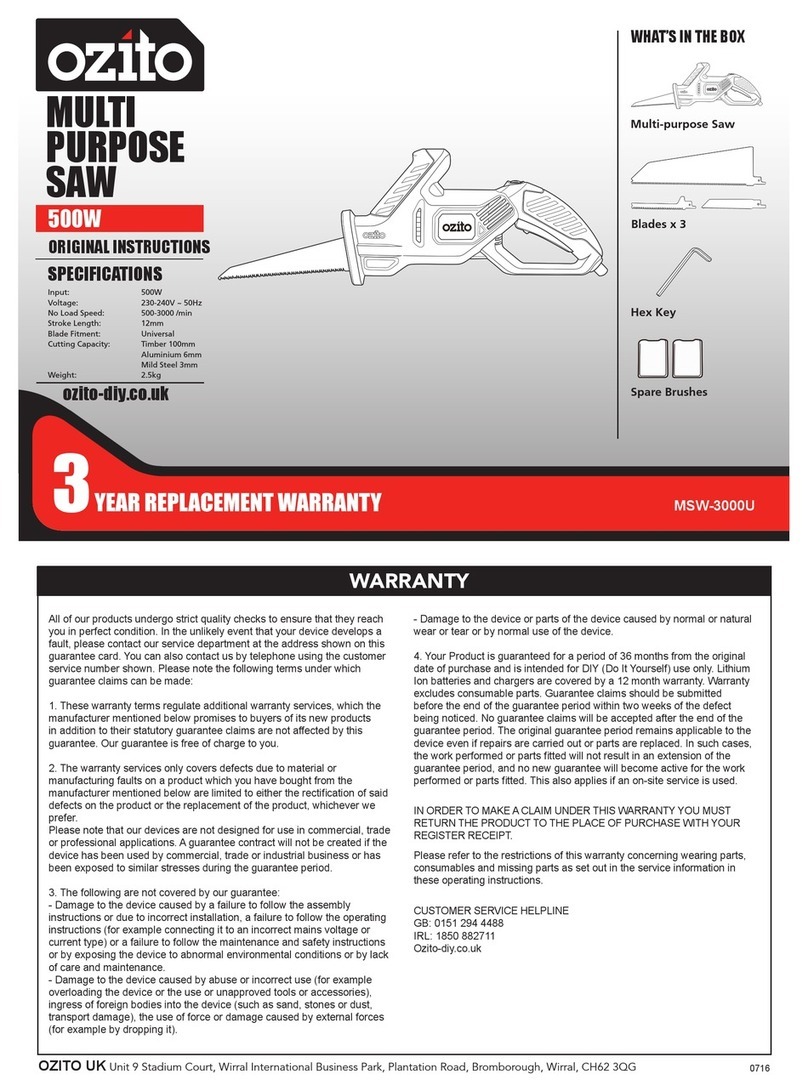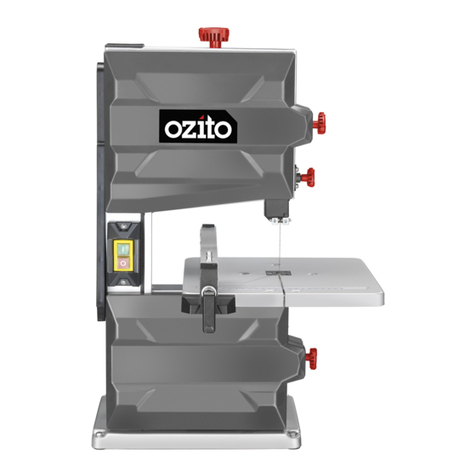Note. The machine must be supplied through a residual current device (RCD) having a rated
residual operating current not exceeding 30 mA for extra protection against electric shock.
• This appliance is not intended for use by persons (including children) with reduced
physical, sensory or mental capabilities, or lack of experience and knowledge, unless
they have been given supervision or instruction concerning use of the appliance by a
person responsible for their safety
• Young children should be supervised to ensure that they don’t play with the appliance
• Make sure that the cutting blade is correctly screened by the guard.
• Never remove the safety guard bracket. The distance between the cutting blade and the safety
guard bracket should not exceed 5mm.
• Do not use cutting blade which is bent, deformed or otherwise damaged.
• Do not use cutting blades which do not comply with the specications stated in this manual.
• Never start cutting tiles before the machine reaches full speed.
• Never attempt to cut extremely small workpieces .
• Do not leave the work area until the machine has been switched off and the cutting disc has
come to a complete standstill.
• Never attempt to stop the cutting blade by exerting pressure on the side of the blade.
• Always unplug the machine before performing any maintenance.
• Do not use the machine before it has been completely assembled and installed according the
instructions.
• Do not perform any design, assembly or construction activities on the table while the machine
is switched on.
• Unplug the machine and clean the table before leaving the work area.
• Take care that the selection of the diamond discs is suitable for the material to be cut.
• Faults in the machine, including guards or diamond discs, should be reported as soon as they
are discovered. Never use the machine without the guard in position.
• Maximum size of working piece should be 1m².
• This tile cutter should be used with limitations on ambient conditions (between 15°C and 30°C).
• Sharp edges and splinters of ceramic tiles can easily cause cuts. Wear work gloves for
handling and while cutting tiles.
• Keep hands away from cutting area and blade.
• Keep your body positioned to either side of the blade, but not in line with the blade. Kickback
could cause the tool to jump backwards.
• Do not reach underneath the workpiece. The guard cannot protect you from the blade below
the workpiece.
• Do not attempt to remove cut material when the blade is rotating. Note that the blade will
continue to coast for a while after the motor is switched off.
• Never wet cut with blades designed for dry cutting. There is danger of blade fracture and
serious personal injury.
• Diamond blades do not cut material, rather they grind material to perform a cutting action. Do
not feed the blade into the tile/masonry faster than the blade can grind.
• Never grind a tile using the side of the blade, or try to make radius or curve cuts. This will
damage the blade and could cause blade fracture.
• Wear suitable personal protective equipment when necessary, this could include hearing
protection to reduce the risk of induced hearing loss, respiratory protection to reduce the risk of
inhalation of harmful dust, wear gloves when handling diamond discs and rough material.
Wear ear muffs
Wear goggles
Wear a breathing mask
Wear gloves
TILE CUTTING SAW SAFETY WARNINGS
WARNING! When using mains-powered tools, basic safety precautions, including
the following, should always be followed to reduce risk of re, electric shock,
personal injury and material damage.
Read the whole manual carefully and make sure you know how to switch the tool off in an
emergency, before operating the tool.
Save these instructions and other documents supplied with this tool for future reference.
The electric motor has been designed for 230V and 240V only. Always check that the power supply
corresponds to the voltage on the rating plate.
The tool is earthed in accordance with AS/NZS 60335-1
Note: The supply of 230V and 240V on Ozito tools are interchangeable for Australia and New
Zealand.
If the supply cord is damaged, it must be replaced by an electrician or a power tool repairer in order
to avoid a hazard.
Using an Extension Lead
Always use an approved extension lead suitable for the power input of this tool. Before use, inspect
the extension lead for signs of damage, wear and ageing. Replace the extension lead if damaged
or defective.
When using an extension lead on a reel, always unwind the lead completely. Use of an extension
lead not suitable for the power input of the tool or which is damaged or defective may result in a risk
of re and electric shock.
WARNING! Read all safety warnings and all instructions. Failure to follow the
warnings and instructions may result in electric shock, re and/or serious injury.
Save all warnings and instructions for future reference. The term “power tool” in the
warnings refers to your mains-operated (corded) power tool or battery-operated (cordless)
power tool.
1. Work area safety
a. Keep work area clean and well lit. Cluttered or dark areas invite accidents.
b.
Do not operate power tools in explosive atmospheres, such as in the presence of ammable
liquids, gases or dust. Power tools create sparks which may ignite the dust or fumes.
c. Keep children and bystanders away while operating a power tool. Distractions can cause
you to lose control.
2. Electrical safety
a. Power tool plugs must match the outlet. Never modify the plug in any way.
Do not use any adapter plugs with earthed (grounded) power tools. Unmodied plugs and
matching outlets will reduce risk of electric shock.
b. Avoid body contact with earthed or grounded surfaces, such as pipes, radiators, ranges
and refrigerators. There is an increased risk of electric shock if your body is earthed or
grounded.
c. Do not expose power tools to rain or wet conditions. Water entering a power tool will
increase the risk of electric shock.
d. Do not abuse the cord. Never use the cord for carrying, pulling or unplugging the power
tool. Keep cord away from heat, oil, sharp edges or moving parts. Damaged or entangled
cords increase the risk of electric shock.
e. When operating a power tool outdoors, use an extension cord suitable for outdoor use.
Use of a cord suitable for outdoor use reduces the risk of electric shock.
f. If operating a power tool in a damp location is unavoidable, use a residual current device
(RCD) protected supply. Use of an RCD reduces the risk of electric shock.
3. Personal safety
a. Stay alert, watch what you are doing and use common sense when operating a power
tool. Do not use a power tool while you are tired or under the inuence of drugs, alcohol
or medication.
A moment of inattention while operating power tools may result in serious personal injury.
b. Use personal protective equipment. Always wear eye protection. Protective equipment
such as dust mask, non-skid safety shoes, hard hat, or hearing protection used for appropriate
conditions will reduce personal injuries.
c. Prevent unintentional starting. Ensure the switch is in the off-position before connecting
to power source and/or battery pack, picking up or carrying the tool. Carrying power
tools with your nger on the switch or energising power tools that have the switch on invites
accidents.
d. Remove any adjusting key or wrench before turning the power tool on.
A wrench or a key left attached to a rotating part of the power tool may result in personal injury.
e. Do not overreach. Keep proper footing and balance at all times. This enables better control
of the power tool in unexpected situations.
f. Dress properly. Do not wear loose clothing or jewellery. Keep your hair, clothing and gloves
away from moving parts. Loose clothes, jewellery or long hair can be caught in moving parts.
g. If devices are provided for the connection of dust extraction and collection facilities,
ensure these are connected and properly used. Use of dust collection can reduce dust-
related hazards.
4. Power tool use and care
a. Do not force the power tool. Use the correct power tool for your application. The correct
power tool will do the job better and safer at the rate for which it was designed.
b. Do not use the power tool if the switch does not turn it on and off. Any power tool that
cannot be controlled with the switch is dangerous and must be repaired.
c. Disconnect the plug from the power source and/or the battery pack from the power tool
before making any adjustments, changing accessories, or storing power tools. Such
preventive safety measures reduce the risk of starting the power tool accidentally.
d. Store idle power tools out of the reach of children and do not allow persons unfamiliar
with the power tool or these instructions to operate the power tool. Power tools are
dangerous in the hands of untrained users.
e. Maintain power tools. Check for misalignment or binding of moving parts, breakage of
parts and any other condition that may affect the power tool’s operation. If damaged,
have the power tool repaired before use. Many accidents are caused by poorly maintained
power tools.
f. Keep cutting tools sharp and clean. Properly maintained cutting tools with sharp cutting
edges are less likely to bind and are easier to control.
g. Use the power tool, accessories and tool bits etc. in accordance with these instructions,
taking into account the working conditions and the work to be performed. Use of the
power tool for operations different from those intended could result in a hazardous situation.
5. Service
a. Have your power tool serviced by a qualied repair person using only identical
replacement parts. This will ensure that the safety of the power tool is maintained.
b. If the supply cord is damaged, it must be replaced by the manufacturer,
its service agent or similarly qualied persons in order to avoid a hazard.
GENERAL POWER TOOL SAFETY WARNINGS
ELECTRICAL SAFETY
